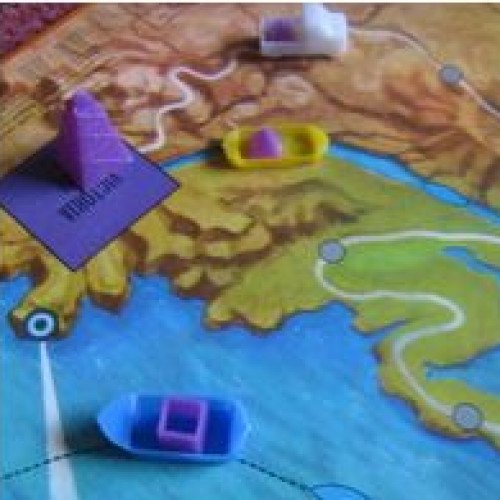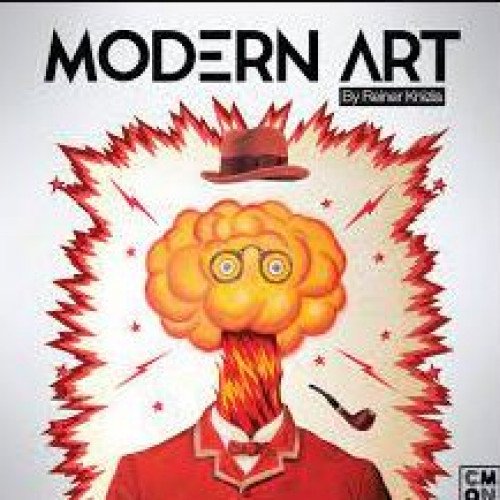"MINE A MILLION" vs "MODERN ART"

MINE A MILLION
Mine a Million or The Business Game is a 1965 board game for 2-6 players previously published by Waddingtons. The game models the economic business of mining tin and gaining profit by transporting it to markets. The "million" in the game's title refers to the target profit players must reach. The game is set in a developing country where transport economy is vital. In this country, the Minister for Transport has decreed that all transport must travel fully loaded. This brings in the concept of subcontracting. The game was designed by Jody Newman and Drew Swinerd, and sold to Waddingtons in 1965. It was later rebranded as The Business Game. The game consists of a playing board, 12 mine derricks (2 of each of 6 colours), 6 lorries, 5 barges, 2 ships, 90 pyramids (15 of each of 6 colours), 94 cubes (24 of each of 6 colours), 26 Production Cards, 6 Canal Company Title Deeds, 2 Production Debit Cards, 1 die and paper money comprising sterling and dollars. Players mine, transport and sell tin in the form of production units. Each player is in control of a pit head with initially a single mining derrick. Tin is produced, after an initial allocation, at the mine by the role of a die. If this tin can be transported to Newport it can be sold for Sterling at Newport warehouse. This money can be used to pay for more transport (lorries, barges and ships) and a second mine derrick (to increase production). The game goes through 3 phases. Initially, transport is carried out using lorries. During this phase the aim is to build up your capital and then increase production. After a time players will have enough funds to establish a canal company so then players can start to use barges on the canals. This is more expensive, but can transport more tin more quickly to Newport. Finally the players begin to transport the production units across the sea by either barges, more slowly around the coast or more quickly by ships. Across the sea at Race Bay, St. John’s or Port Boston units can be sold for dollars. Before exporting by sea, a player needs to have acquired sufficient money (sterling) to pay for the transport rental during the sea journey.
Statistics for this Xoptio

MODERN ART
Modern Art is an auction game designed by Reiner Knizia and first published in 1992 by Hans im Glück in German. Players represent art dealers, both buying and selling works of art by five different fictional artists. At the end of each round, they sell the paintings they bought back to the "bank". More popular artists' works are worth more, and the value carries over into future rounds. Although the game is played entirely using cards, a board is used for scoring, so the game is sometimes referred to as a board game. Each player is dealt a hand of cards, which represent works of art that the player may offer for sale. Players then take turns putting these cards up for auction. There are several auction formats; the one used is determined by the card offered for sale. As soon as a fifth work of art by a particular artist is offered for sale, the round ends (the fifth painting is not sold). Players then sell purchased artwork back to the bank — the more paintings of an artist that were sold in the round, the more that artist's paintings are worth. Only the three most popular artists' paintings are worth money; the others are worthless. Ties are broken by a fixed artist precedence. The game has a board to keep track of the value of a given artist's painting. Each artist occupies a column. The leftmost artist is always preferred in case of ties. The number of paintings in the deck reflects this; with the leftmost artist having the fewest paintings, and the rightmost artist having the most paintings. The game is played in four rounds. In the second, third, and fourth rounds the value of paintings at the end of a round depends not just on how the artist did in that round, but carry over from previous rounds as well. Players are dealt additional cards in the second and third (but not fourth) rounds. The player with the most money at the end of the fourth round is the winner.